Oberlin Blogs
Keep-ing it Real
January 20, 2011
Tess Yanisch ’13
Spending Winter Term on campus can be fun, community-building, and very rewarding. The only drawback (besides the cold) is the question of obtaining food. Though Dascomb dining hall is open, Winter Term is not covered by regular CDS meal plans. You have to purchase them separately. To save money, many students forage in the wild--by which I mean they cook for themselves. Generally, I think this works out okay. SURGEON GENERAL'S WARNING: A diet consisting solely of ramen, instant mac'n'cheese, and peanut-butter sandwiches may lead to scurvy.
However, this being Oberlin, there is a sociable, scurvy-avoiding alternative: group cooking! (Check here for Ma'ayan's "foodship.") The most common group arrangement is the dining co-op. Winter Term co-ops obviously differ in membership from regular semester co-ops--some people are gone, some new people come in. Somehow, this year, Sci-Fi Hall managed to take over Keep, the co-op nearest to North. I think there are a few regular live-in Keepers eating with us, but mostly, we have staged a coup.

It's actually a great arrangement. I tend to be too busy and/or enmeshed in my pre-existing friend group to spend as much time as I would like to hanging out with people on Hall. Now, I'm eating dinner with them every day, and lunch with a certain subset--those people who get hungry and wander in at about the same time I do. (Most co-ops cook lunch and dinner. We just make extra food at dinner and then people eat leftovers for lunch.)


Side views of Keep.
I don't have much basis for comparison, but I think we're unconventional by OSCA--Oberlin Student Co-operative Association--standards. Co-ops are technically run by a complex democratic process, called, I believe, "co-op consensus." People vote by thumbs-up, meaning anything from "I love this idea" to "I can live with it," versus thumbs-down, meaning "if this passes, I will leave the co-op." You raise your hand to participate in discussions. There are several signs you can use in this process: a hand means you have an announcement, one finger is a clarifying statement, an O is a question . . . something like that. I don't actually know, because we had a vote on the first night during which we scrapped this system entirely. Instead, we installed a benevolent shadow government composed of people who had co-op experience and were willing to take on the administrative roles (food buyer, OSCA liaison, etc.). They're really not all that shadowy, considering that we know who they are and they told us when they'd be meeting and offered to train in anybody who was interested.
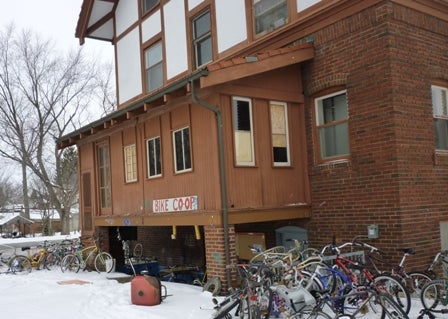
People also volunteered to be head cooks each night. So far, this has worked out very well--people who enjoy cooking tend to be good at it. One of our most frequent volunteers was gone the last two semesters, which she working as a chef at a gourmet vegan restaurant in California. I like this arrangement.

Of course, it's not just the compulsively responsible and the experienced chefs who do any work. Everyone has to do three shifts of work a week. There are sign-up sheets for prep chefs, crews (post-meal clean-up), and commandos (weekly cleaning blitzes). You can also get in a shift by baking bread or making a "tasty thing." I was a tasty-thing maker this week--I made cinnamon rolls! More about this endeavor later.
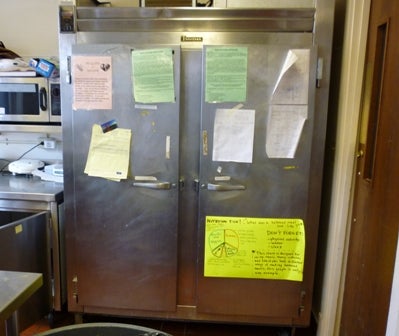
I've done several crews, working mostly on the dishwashing front. I now know how to use a Hobart. Dishes, cups, and flatware in co-ops are not washed by hand or by machine. They are purged of all food scraps by warm water spray and diligent hand-scrubbing, then loaded into large plastic racks. These racks are then loaded into the Hobart, a magical metal box that bathes them in sanitizer and steam. The dishes emerge freshly sanitized and painfully hot.


Larger things--pots, pans, giant plastic leftover containers--are cleaned in a more traditional manner, scrubbed by hand and rinsed in sanitizer-water, then left to dry. No real soap is used in this process, which bugs the more OCD of us no end. As far as I'm concerned, if something is still greasy to the touch, regardless of how anti-bacterial-ized it might be, it must be cleaned again!! But the Ohio health code doesn't agree. Whatever.


I've prep-cooked once so far. It was on Pizza Night, a beloved co-op tradition, and the pace was intense. I chopped eight or nine onions (weep, weep for the onions!), rolled out dough, slathered on tomato sauce and delicious cheeses, and garnished them liberally with green peppers, broccoli, the onions, avocado, and whatever else we found in the fridge that looked tasty. It was a lot of fun.

Like other co-ops, we have "special meals" every now and then. Besides the weekly Pizza Night, there's a Lord of the Rings-themed one coming up, and I've heard rumors of a Klingon meal after that. The only one we've had so far was broccoli night, in which every dish served contained broccoli. We had gnocholi (gnocchi with broccoli in it), pestocoli (pesto with broccoli in it), blockoli (baked bread/tofu/broccoli bricks, not to be confused with Soylent Green), tomato sauce (with broccoli), cannocoli (cannoli with broccoli in the filling), and broclava (baclava with broccoli in it) for dessert. Oh, and some steamed broccoli on the side.


Now: the cinnamon rolls! I had wanted to do this since I learned about the Winter Term co-op and appropriated a recipe from home for this express purpose. It looked delicious and I expected the cinnamon rolls to be universally beloved. Or at least almost universally beloved--this particular recipe called for milk, butter, and eggs, so the vegans wouldn't be able to eat it, but I think we only have a few vegans in the co-op.
Then, the day of the operation, I realized it was the day before delivery day. That's right: no milk, and only enough eggs for a single batch. There are thirty-some people in this co-op--one batch wasn't going to cut it. So Emma and I bought milk and eggs and got to work. We began around noon.

Enter hurdle Number Two: flour. Cinnamon rolls are basically white bread with brown sugar and cinnamon. However, co-ops apparently only stock whole wheat and rye flour. Emma and I used up the last of our stock of whole wheat making the dough of the new innovation: good-for-you cinnamon rolls! By the end, we had to knead in the new flour. This was a very sticky business.

Once the dough was a little less adhesive, we left it to rise. Emma went back to the room to do work. I stuck around in the dining room, watching Stephen Colbert clips on my computer and checking on the dough periodically.

By the time the dough was ready, a little after 3:00, that evening's cook had arrived. We chatted as I split the dough in half--there was too much to deal with all at once--kneaded it down, and began to roll it out.

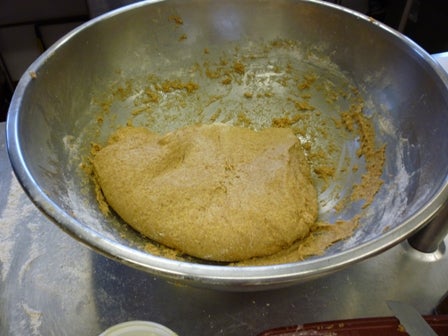
Allow me a moment's tangent about bread. I had never made bread all (or mostly--Emma's help was invaluable) on my own before, and I hadn't helped anybody make bread in a long time. I'd forgotten how good it smells, how smooth and stretched it gets when it's risen. There is something magical about yeast: it makes the bread itself almost alive. It smells clean and somehow organic. It grows. When you punch it down, you realize that it's warm to the touch. A lump of smooth, kneaded, well-floured dough feels a little like a baby. (Not that I have ever, or would ever, knead a baby. I just mean it's firm and warm and . . . Oh, don't mind me. I also think polenta smells like skin.) All I mean is that it's easy to see how cults developed around bread.
Yes, yeast is an amazing thing. These tiny little organisms make so much possible. And yet I wonder: how did people figure this out? You hear Dave Barry's origin stories about beer where someone accidentally dropped bread dough into water and then drank the water a week later--okay, I'll buy that, I guess. But where did the yeast in the bread dough come from? Who was the first person to say, "Hey, there's something in this stuff that makes my water bubble. I think I'll put it in this bread"?


Once the dough was rolled out, I spread melted butter over it, then a layer of brown sugar, then sprinkled it liberally with cinnamon. Then I rolled it up into a long log. That was one of the most difficult moments in the whole process: getting a nice, tight, even roll.

My bread-slab wasn't perfectly even, so some of the rolls had many clean, tight layers, while others had just a few loose ones. I re-rolled some of these by hand and twisted some others into little knots.

This process was repeated on the second half of the dough. This time, though I sprinkled the brown sugar on liberally, I forgot to put the cinnamon on and only realized my mistake when I was halfway through slicing up the roll (a much tighter one this time; I improve with practice). I sprinkled the cinnamon over the top instead and called it good.


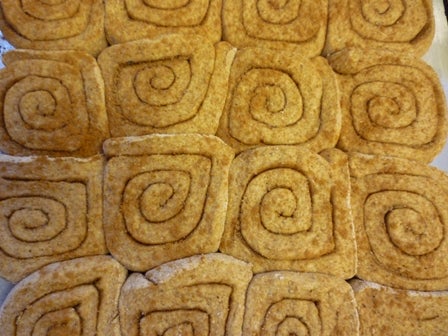
The rolls had to rise again, so I took a break. A little over an hour later, I popped them into the oven. Emma was there to prep-chef and looked at them on the pan. She'd been the one to inform me that one can, in fact, make cinnamon rolls on cookie sheets--at home, we make them in deeper pans, so I for some reason thought that was the only way they could be made. "They're all stuck together," she said. "Won't you get one giant cinnamon roll?"
"You slice them, of course," I replied, puzzled. "How do you make them?"
"Spaced out, like cookies."
Another cooking culture shock.
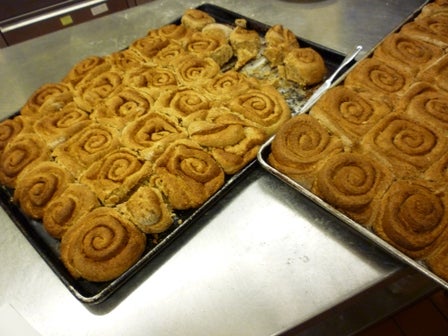
The cinnamon rolls came out of the oven shortly before dinner started. They were shorter than cinnamon rolls usually are, probably because of the whole wheat flour, but they were delicious!
I wrote out an ingredient list on a napkin--ingredient lists are required so no one accidentally ingests anything they're allergic to, and so that things can be clearly labeled as meaty, vegetarian, vegan, non-honey vegan, gluten-free, etc.*
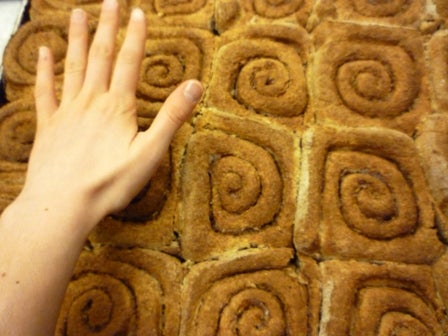
I swept into the dining room with my trays of cinnamon rolls and deposited them on the table. To my delight, people enjoyed them. Baking is very satisfying.
* I have a funny story about ingredient lists, actually. The day after I made the cinnamon rolls, I came in to find a cookie tray in the kitchen labeled "FAIL BREAD." The ingredient list contained the usual suspects in the field of bread-making, but ended, "rye flour yeast shame." Apparently it wasn't supposed to be made with rye flour, but I'd used up all the wheat and the new shipment hadn't arrived yet. It also hadn't risen properly. A few of us cautiously tested it. It was about the same consistency as a chewy cookie. After careful deliberation, we decided it was like tortillas--you wouldn't eat it on its own, but it could be a good vehicle for something else. I had mine smeared with honey; others tried it with peanut butter or drenched in maple syrup.
Similar Blog Entries
Mon Voyage Magnifique à Bordeaux - Part 3
March 31, 2025
Part three of a review of my magnificent French immersion trip to Bordeaux, France, focusing on the excellent cuisine.


Mon Voyage Magnifique à Bordeaux - Part 1
February 28, 2025
Part one of a review of my magnificent French immersion trip to Bordeaux, France, focusing on my host family experience there.
